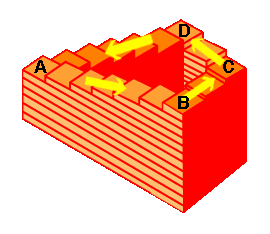“The illusion arises because our eyes cannot perceive depth directly from the visual scene: the eye only records a two-dimensional projection of a three-dimensional world. Our visual system employs a number of visual cues to help us extract distance information from a flat image. Among these cues are interposition (where an object in front will hide things that are behind it and perspective transformations (where a square object will appear as a trapezoid if we are looking at it from an angle).
“My staircase uses both of these cues to fool your eyes. The first thing to realize is that the staircase is not an object with depth. Instead it is just a two dimensional image with no depth at all. But interposition and perspective transformations lend it the appearance of an object that has depth.
“For example, the dark orange shape below B and C appears to be a square that is oriented away from us, rather than the flat trapezoid it really is. Therefore, C appears farther away than B. Because we can see the stairway treads, the diagram gives the illusion that C is higher than B.”
